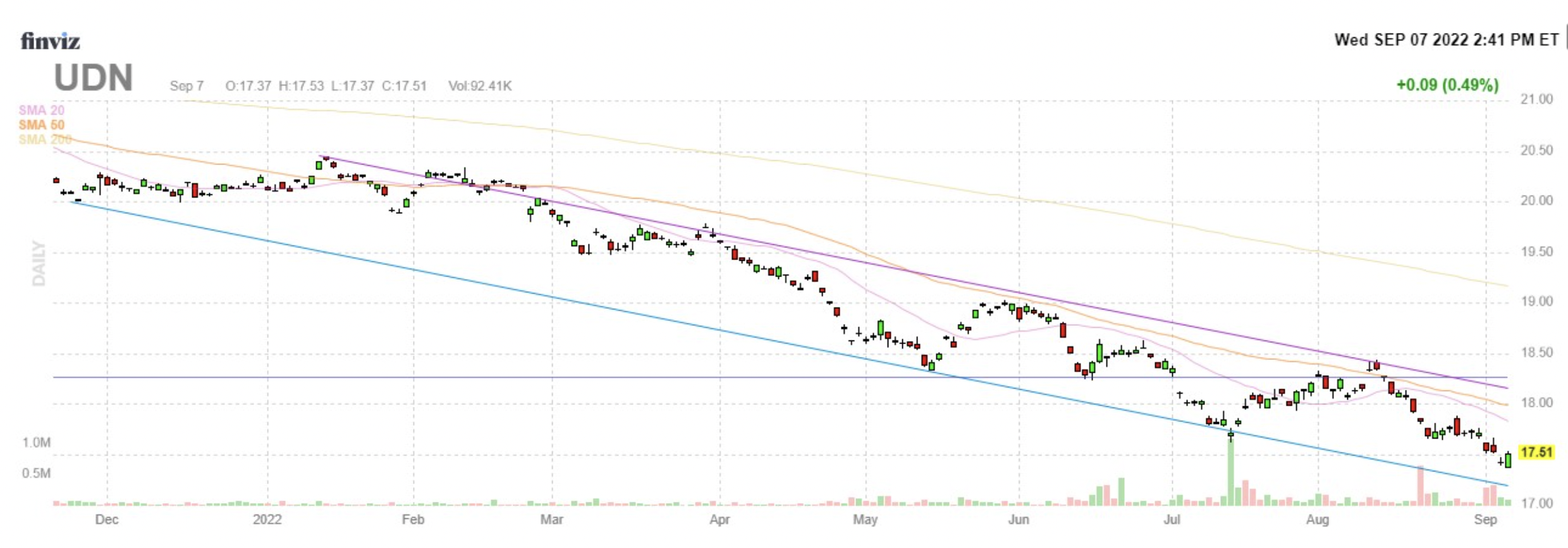Next 6-12 months crucial for prediction platforms like Kalshi and Polymarkets
The interesting thing about Tuesday’s price action was that crude ended the day flat, or just slightly higher after OPEC announced the production cut over the weekend. In addition, with the NordStream1 announcement last Friday, natural gas also did very little yesterday, despite what is being spun as horrid news for natural gas users across Europe this winter.
The expectation (at least I thought) was that crude oil and natural gas would have been screaming higher at the open on Tuesday morning.
Have we reached maximum bearishness for Europe ? After the Nordstream1 headline, it seems hard to believe that the headlines could get much worse.

Gary Morrow, a technician this blog religiously follows, posted this chart to LinkedIn today, whereby I promptly asked him to expand the chart so I could show it to readers, and it shows a potential reversal in the Invesco DB US Dollar Index Bearish Fund (NYSE:UDN), which means that the dollar could be on the verge of weakening, which, in my opinion, could be a big plus for the U.S. stock and bond markets.
The Invesco DB US Dollar Index Bullish Fund (NYSE:UUP) is the dollar-related ETF that I’ve written about frequently over the last month, as the dollar index has reached 22-year highs. While a strong dollar is actually deflationary, it’s been too strong and it impacts capital flows and quarterly earnings. At first, the dollar impact on S&P 500 revenue is “translational,” meaning it impacts or influences non-U.S. revenue within a company that then must be “translated” or adjusted to reported revenue. The influence is mostly minor, but after a long run of strength or weakness, the dollar effect becomes “economic,” meaning it materially influences trade flows.
It’s still easy to remember the G-6 (or maybe by then it was the G-7) meeting in the mid 1980s after the dollar screamed higher on President Ronald Reagan’s economic policies. That dollar strength caused a lot of pain in the Rust Belt in the Midwest or heartland of America as basic material industries and grain exporters were just crushed on the dollar’s strength. It lasted at least three to four years before the central bank coordination started to gradually weaken the buck.
Why is the dollar so strong today?
Reaching all the way back to my CFA exam prep days, the three big influences on relative currency action is:
- Relative monetary policies;
- Relative fiscal policies;
- Relative “real” (inflation-adjusted) interest rate levels;
It’s seem clear now, almost a year into when Fed Chair Jay Powell started jaw-boning about the coming tightening cycle, that the Fed would be the first to raise rates around the globe. By that, I mean amongst the Fed, the European Central Bank, the Bank of Japan and the People’s Bank of China. That alone would strengthen the buck, and likely has since if you were a foreign bank or investor, and you knew the Fed would be raising rates for a period of time. Wouldn’t you want to own short-term Treasuries? Probably the safest security in the world from a credit perspective?
Relative fiscal policies and relative real rates: I’m not sure how that plays in here. It’s tough to gauge fiscal policies outside the U.S. We will only see it when inflation falls, and that’s poised to start happening next week with the CPI and PPI data being released. That is where “real” rates would actually start to rise.
To answer the question directly, I suspect that today a lot of the dollar strength is monetary policy-driven. But it could be the rest of world is still beat down by COVID and its aftermath.
Keep an eye on the Invesco DB US Dollar Index Bullish Fund (NYSE:UUP) and Invesco DB US Dollar Index Bearish Fund (NYSE:UDN) over the next week or so. The UUP can’t be bought for clients because it generates a k-1. Even if it’s bought in an IRA account, it’s purchase can generate a distribution or even alter the tax-deferred status of the account (yikes).
Clients are long Oakmark International, the iShares MSCI Emerging Markets ex China (NASDAQ:EMXC) ETF and a small position in the SPDR® Gold Shares (NYSE:GLD) for a play on dollar weakness. (This doesn’t mean that the instant the dollar weakens, these positions will outperform. But if you look at the longer-term “annual” returns on all three positions, all are a hedge against the large-cap growth performance premium of the last five years.
Last Thursday’s S&P 500 low of 3,903.65 is still intact.
Take all this as simply one opinion, and time could prove all this very wrong, and past performance is no guarantee of future results. Capital markets can change very quickly and lousy markets can last for a very long time, much longer than you think.
